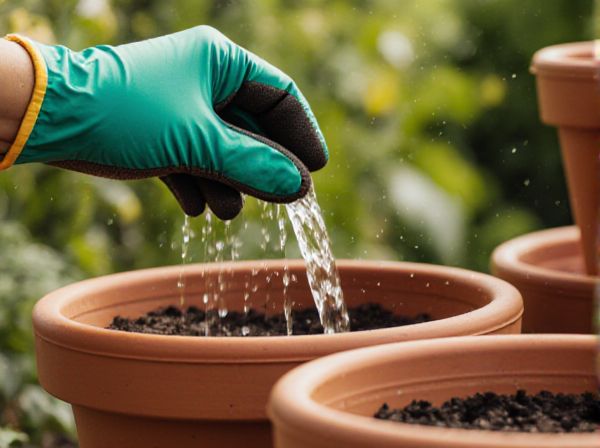
Self-watering pots vs Traditional pots Illustration
Self-watering pots maintain consistent moisture levels by using a reservoir that delivers water directly to plant roots, reducing the risk of overwatering and root rot common in traditional pots. Traditional pots require frequent manual watering, which can lead to uneven soil moisture and stress plants during dry spells. Choosing self-watering pots enhances plant health and saves time, especially for busy gardeners or those in hot climates.
Table of Comparison
| Feature | Self-Watering Pots | Traditional Pots |
|---|---|---|
| Watering Frequency | Less frequent; water reservoir supplies steady moisture | Requires regular manual watering |
| Water Retention | High; minimizes evaporation and runoff | Lower; more water lost through evaporation |
| Plant Health | Consistent hydration reduces stress and root rot risk | Risk of over or underwatering, causing stress |
| Maintenance | Low; refill reservoir as needed | High; frequent watering and drainage monitoring |
| Ideal Use | Busy gardeners, indoor plants, drought-prone areas | Experienced gardeners, outdoor plants requiring variable moisture |
| Cost | Higher initial cost | Lower upfront cost |
Introduction to Self-Watering Pots and Traditional Pots
Self-watering pots feature a built-in reservoir that supplies consistent moisture to plants, reducing the frequency of watering and preventing overwatering. Traditional pots require manual watering, relying on regular attention to ensure that soil remains adequately moist, which can lead to uneven hydration and plant stress. The design of self-watering pots supports healthier root development by maintaining optimal moisture levels, whereas traditional pots often demand careful monitoring to avoid waterlogging or drought conditions.
How Self-Watering Pots Work
Self-watering pots operate by using a reservoir at the base that supplies water directly to the plant's roots through capillary action, ensuring consistent moisture levels. This system reduces the frequency of watering by maintaining a steady supply of water, preventing overwatering and root rot. Traditional pots lack this mechanism, requiring more frequent manual watering and often resulting in uneven soil moisture.
Water Retention in Traditional Pots
Traditional pots often struggle with water retention due to their porous materials like terracotta, which allow moisture to evaporate quickly. This results in more frequent watering requirements and increased risk of under-watering plants. Unlike self-watering pots that maintain consistent soil moisture, traditional pots demand closer monitoring to prevent drought stress in plants.
Plant Health: Comparing Both Pot Types
Self-watering pots maintain consistent moisture levels, reducing the risk of root rot and promoting healthier root development compared to traditional pots, which require more frequent watering and can lead to soil drying out unevenly. Traditional pots often result in fluctuating moisture, stressing plants and potentially causing nutrient deficiencies. Research shows plants in self-watering pots demonstrate improved growth rates and more vibrant foliage due to stable hydration conditions.
Water Conservation: Self-Watering vs Traditional
Self-watering pots significantly reduce water waste by delivering a consistent moisture level directly to plant roots through a built-in reservoir, promoting efficient water use compared to traditional pots that rely on surface watering. Traditional pots often lead to overwatering or runoff, resulting in higher water consumption and less sustainable gardening practices. Studies show self-watering systems can conserve up to 50% more water by minimizing evaporation and drainage losses.
Maintenance Requirements and Ease of Use
Self-watering pots significantly reduce maintenance requirements by providing a consistent water supply through a reservoir, minimizing the need for frequent watering and lowering the risk of over- or under-watering. Traditional pots demand regular manual watering and closer monitoring to prevent soil dryness or waterlogging, increasing time and effort for plant care. The ease of use in self-watering pots benefits both novice and busy gardeners by simplifying plant hydration and promoting healthier growth with less intervention.
Cost Analysis: Upfront and Long-Term
Self-watering pots typically entail a higher upfront investment due to integrated reservoirs and advanced materials, whereas traditional pots are more affordable initially but often require more frequent watering and maintenance, increasing labor costs. Over the long term, self-watering pots reduce water usage and plant care time, offering cost savings on utilities and labor that can offset the initial expenditure. Traditional pots may incur additional expenses related to water waste and potential plant health issues from inconsistent watering, impacting overall cost efficiency.
Ideal Plants for Each Pot Type
Self-watering pots are ideal for moisture-loving plants like ferns, peace lilies, and herbs, as they provide consistent hydration that prevents over or underwatering. Traditional pots suit drought-tolerant plants such as succulents, cacti, and lavender, which prefer the soil to dry out between watering sessions. Selecting the right pot type based on a plant's water needs promotes healthier growth and reduces maintenance efforts.
Common Issues and Troubleshooting
Self-watering pots reduce frequent watering errors such as overwatering and underwatering by maintaining consistent soil moisture through a reservoir system, while traditional pots often suffer from inconsistent watering leading to root rot or dryness. Common issues with self-watering pots include algae growth in the reservoir and clogging of the wicking system, which can be resolved by regular cleaning and ensuring proper placement of the water level indicator. Traditional pots require vigilant monitoring and troubleshooting like adjusting watering frequency and checking drainage to prevent water accumulation and ensure healthy root aeration.
Choosing the Right Pot for Your Gardening Needs
Self-watering pots offer consistent moisture control by automatically regulating water levels, reducing the risk of overwatering and making them ideal for busy gardeners or drought-prone areas. Traditional pots require manual watering, providing more control over soil moisture but increasing the chances of under- or overwatering, which can stress plants. Selecting the right pot depends on plant species, watering frequency, and gardener availability to ensure optimal growth and health.
Self-watering pots vs Traditional pots Infographic

 gardendif.com
gardendif.com